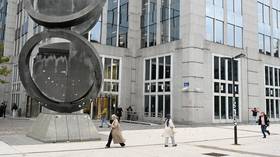Mars: Consider yourself at home
On October 31, Earth’s 7-billionth inhabitant was born. The population is due to hit 10 billion in just a few decades, bringing thoughts of colonizing a new planet. But which one? Mercury is too hot; Pluto is too cold. Mars? That’ll do nicely.
As the population of Earth passes the seven billion mark, some have suggested the Red Planet as a replacement for our current blue one. However in these times of tightening purse strings, the cost of getting to Mars could be a problem.“A one-man expedition to Mars and back would cost, it is safe to say, 100 billion roubles [some $3.3 billion],” says Igor Lisov, an expert from the Cosmonautics News magazine. “Preparing for these flights would cost about 30 or 50 times more than a two-way ticket. In other words, we are talking about colossal expenses.”Regardless of the price, those who have been into space say the time is right for mankind to boldly go where no-one has gone before.“Everybody realizes that it is time to reach out and explore the universe beyond low-Earth orbit,” says NASA astronaut Mark Polansky. “We have for many years – ten years at least – been on the International Space Station in low-Earth orbit which is very close, and we haven't been anywhere else with people since the lunar landings which ended in 1972.”There is no shortage of takers to be the first to set foot on Mars, and wannabe Red Planet trail-blazers have started their training young.Sergey Davitaia is still just a teenager, but he is putting in the hard yards in the hope that he can help create a potential new home for humanity millions of kilometers away.“I want to be the first to travel to Mars and to other planets as well – to the moons of Jupiter or Saturn,” Davitaia says. “They say we can live there in the future.”We are still a long way from science fiction becoming science fact with humans setting up home on the surface of Mars. Even if we put the huge cost of a Martian settlement to one side, there are some serious hurdles to overcome. Not least, we have no idea if life existed there previously, and if it did, whether whatever killed it off could be dangerous to us.And why should we even think about finding a new home?“Earth’s resources are finite, therefore we will eventually have to either restrain population and production growth, risking losing both, or we find footholds on other planets no matter how much it costs us,” explains Igor Lisov.With the retirement of NASA's space shuttle, the only way for people to get into space at the minute is the Russian Soyuz rocket. Currently, with the science available, our chances of a global relocation any time soon are pretty much zero. However, tucked away in central Moscow, the Mars 500 project is simulating the effects a mission to Mars would have on a crew in search of a new home.“There is one obvious reason why the experiment has been so popular,” explains Igor Ushakov from the Institute of Medical and Biological Problems.“The world is still a place for dreamers who dream of exciting projects that unite people – international projects.” As it stands, we might have to simply learn to deal with the soaring global population. But young Sergey will keep on training hard in the hope that he can bring the dream of a new, inter-planetary home a little closer to becoming a concrete reality.














